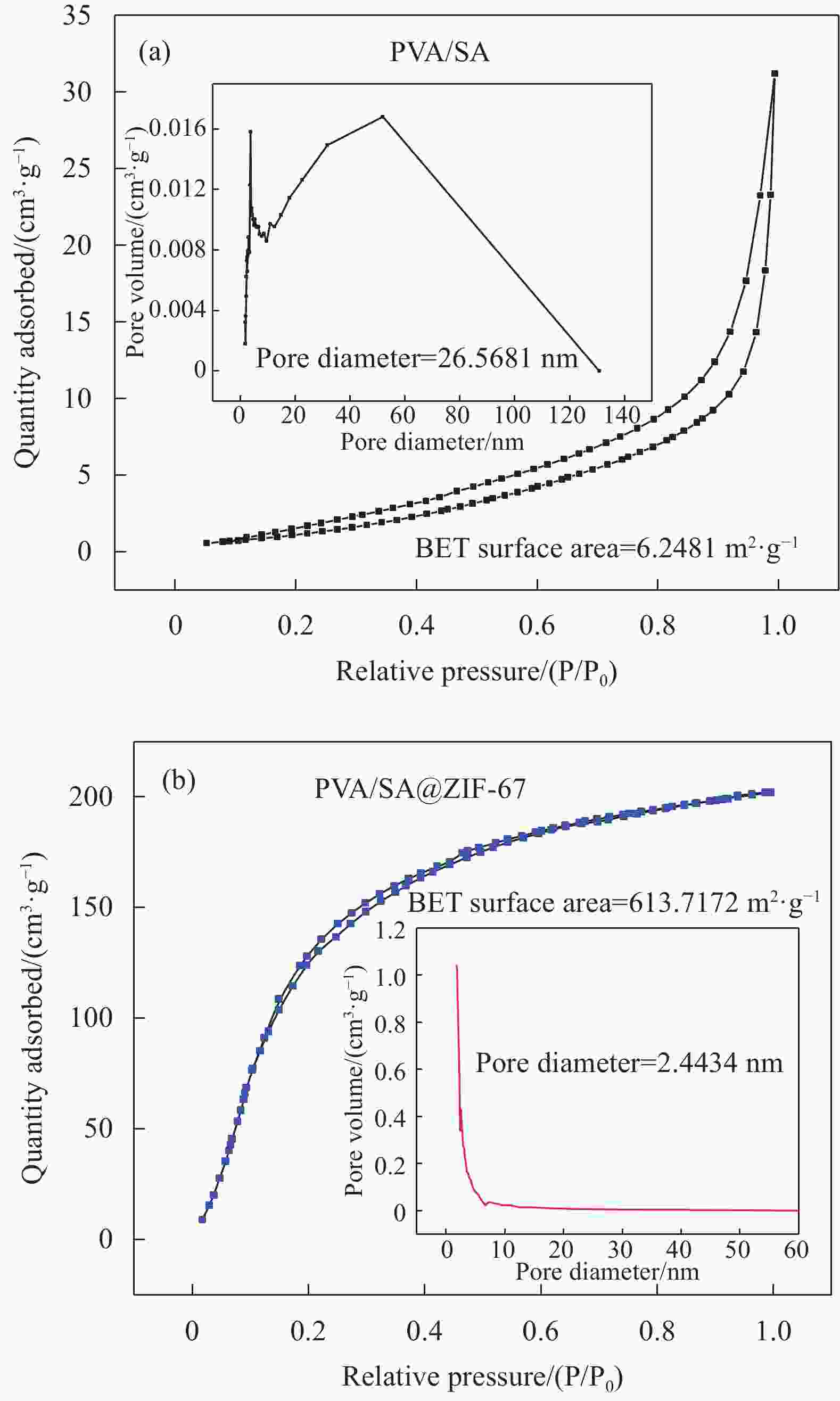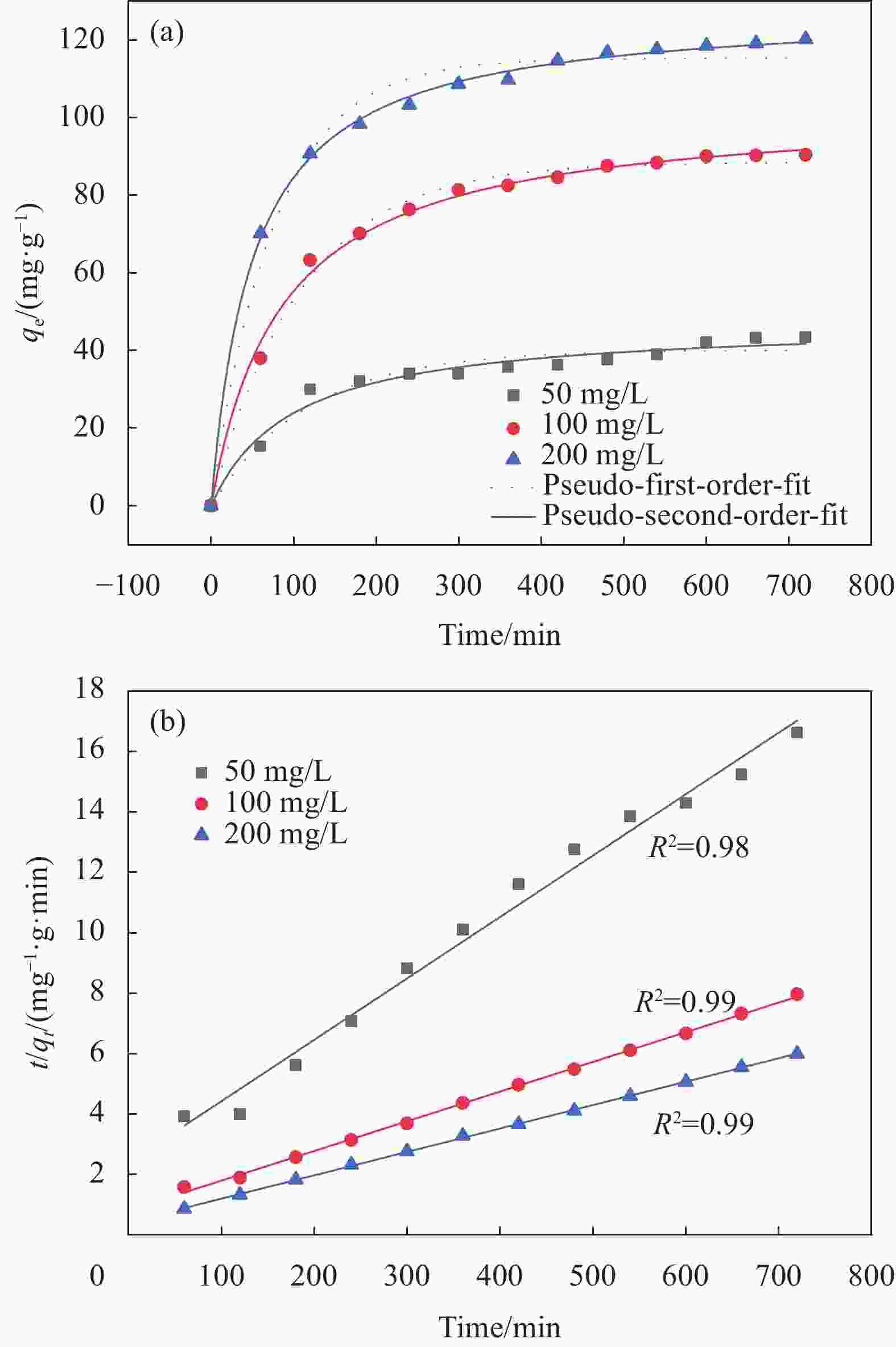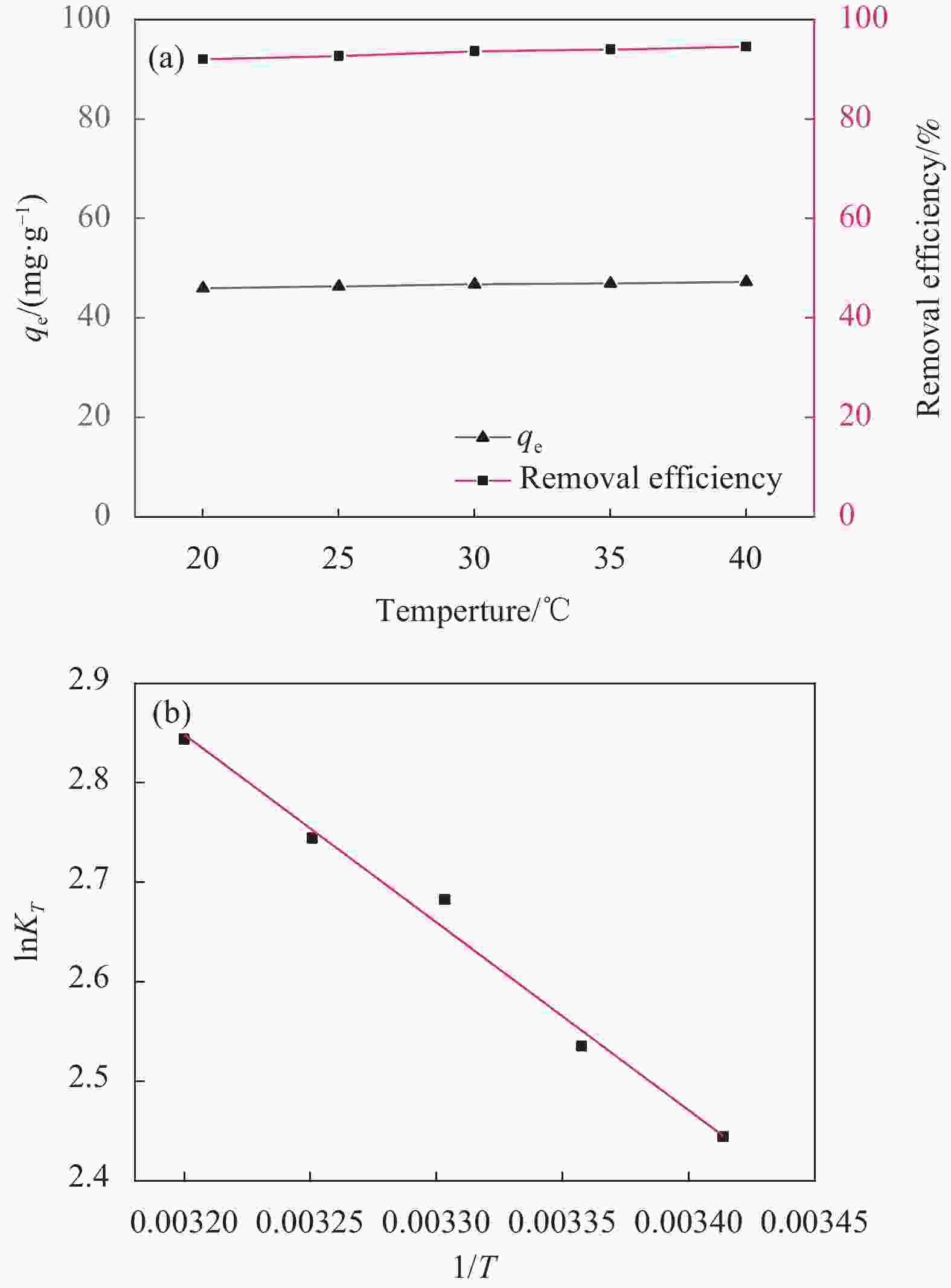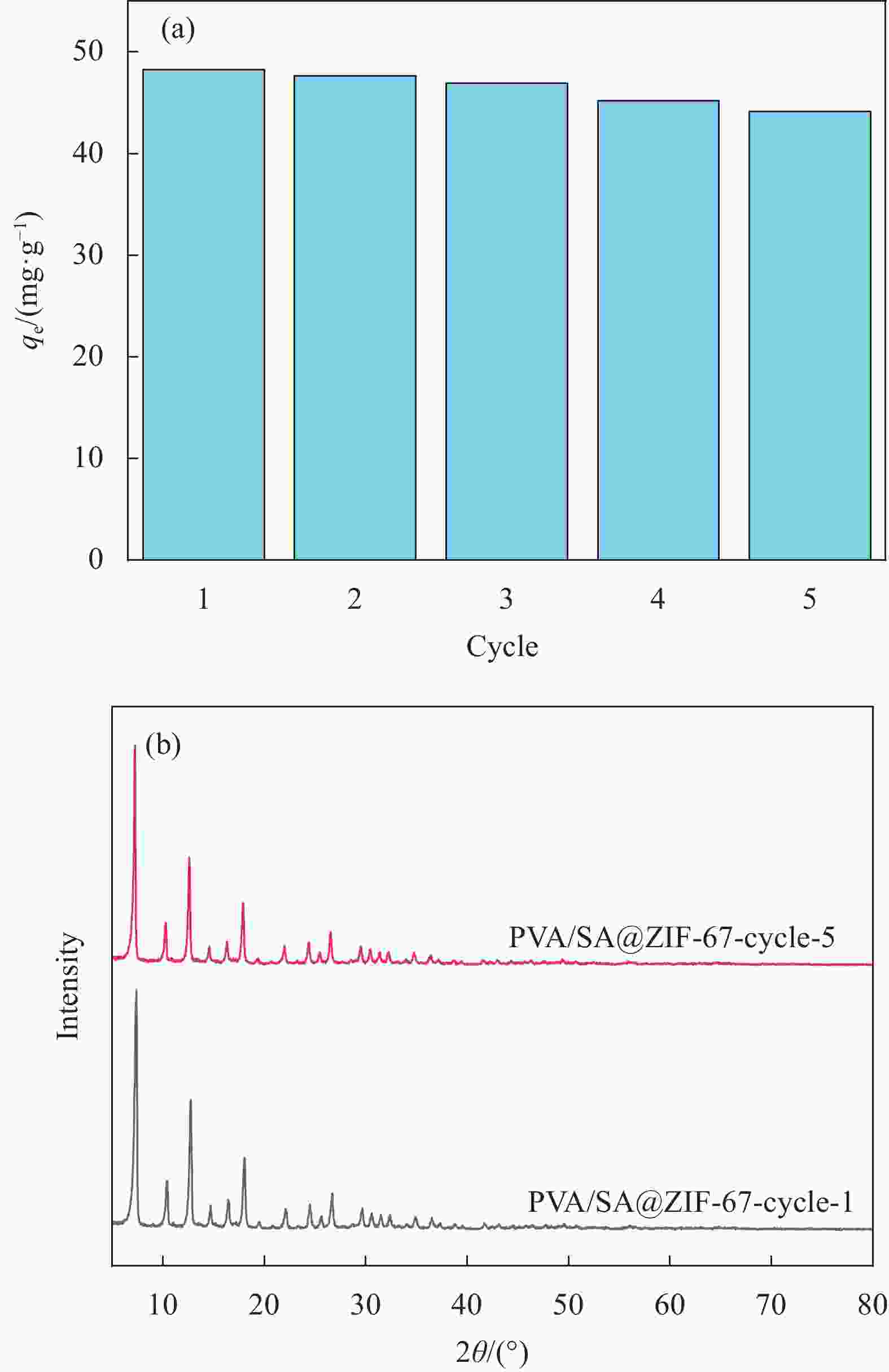Fabrication of polyvinyl alcohol/sodium alginate in-situ growth ZIF-67 hydrogel and its application to enhance the adsorption performance of Cu(II)
-
摘要: 本研究致力于提高天然聚合物凝胶的力学性能,并解决粉末状 MOF 材料在吸附水体中 Cu(II) 方面的局限性。因此,本研究采用金属有机框架材料(ZIF-67)和聚乙烯醇/海藻酸钠(PVA/SA)水凝胶,通过原位生长法,设计并制备了 MOF 和聚合物复合水凝胶材料。通过傅立叶变换红外光谱(FT-IR)、扫描电子显微镜(SEM)、Brunauer-Emmett-Teller(BET)、X射线光电子能谱(XPS)和X射线衍射(XRD)对合成的水凝胶球进行了表征,证实了金属有机框架(MOF)材料在聚乙烯醇/海藻酸钠(PVA/SA)水凝胶球上的原位生长。利用氮吸附-解吸等温线测量了复合水凝胶的比表面积和孔径,分别为 613.7 mg·g−1和 2.44 nm。研究了复合水凝胶对水体中 Cu(II) 的吸附特性、热力学和动力学模型以及吸附机制。实验结果表明,Cu(II) 的最佳吸附 pH 值为 5,最大吸附容量为 128.4 mg·g−1,分别是普通 SA 和 PVA/SA 水凝胶的 3.3 倍和 1.8 倍。吸附过程更符合 Freundlich 等温线模型(R2 = 0.96-0.99),吸附动力学更符合拟二阶模型(R2 = 0.973-0.998)。热力学分析表明,吸附过程是吸热且自发的,温度升高更有利于吸附过程。复合材料的主要吸附机制是络合、阳离子交换和物理吸附。这是由于吸附过程中 —OH 和 —COOH 基团的参与以及 Ca(II) 和 Cu(II) 的离子交换作用。循环吸附分析实验表明,PVA/SA@ZIF-67 在 5 次吸附循环后仍能保持 90% 以上的原始吸附容量。在不同的水样环境中对 Cu(II) 的选择性去除进行了试验。PVA/SA@ZIF-67 对铅(II)和铜(II)的吸附性能远远优于镉(II)、锌(II)、镍(II)和锰(II)、Ni(II) 和 Mn(II)。Abstract: In this study, an effort was made to enhance the mechanical properties of natural polymer gels and address the limitations of powdered MOF materials in the adsorption of Cu(II) in water. To this end, a MOF and polymer composite hydrogel material was designed and prepared through the use of metal-organic framework materials (ZIF-67) and polyvinyl alcohol/sodium alginate (PVA/SA) hydrogels via a situ grow method. The synthesized hydrogel spheres were characterized by Fourier transform infrared spectroscopy (FT-IR), scanning electron microscopy (SEM), Brunauer-Emmett-Teller (BET), X-ray photoelectron spectroscopy (XPS) and X-ray diffraction (XRD), confirming the in-situ growth of metal-organic framework (MOF) material on polyvinyl alcohol/sodium alginate (PVA/SA) hydrogel spheres. The specific surface area and pore size of the composite hydrogel were measured using nitrogen adsorption-desorption isotherm to reach 613.7 mg·g−1 and 2.44 nm, respectively. The adsorption characteristics, thermodynamic and kinetic modelling and adsorption mechanism of Cu(II) in water by composite hydrogels were investigated. The experimental results demonstrated that the optimal adsorption pH of Cu(II) was 5, with a maximum adsorption capacity of 128.4 mg·g−1, which was 3.3 and 1.8 times that of ordinary SA and PVA/SA hydrogels, respectively. The adsorption process was found to be more consistent with the Freundlich isotherm model (R2 = 0.96-0.99), while the adsorption kinetics was more consistent with the pseudo-second-order model (R2 = 0.973-0.998). Thermodynamic analysis revealed that the adsorption process was endothermic and spontaneous, and that increasing the temperature is more conducive to the adsorption process. The main adsorption mechanisms of composite materials are complexation, cation exchange and physical adsorption. This is due to the participation of —OH and —COOH groups and the ion exchange of Ca(II) and Cu(II) in the adsorption process. PVA/SA@ZIF-67 can still maintain more than 90% of its original adsorption capacity after 5 adsorption cycles, as demonstrated by cyclic adsorption analysis experiments. The selective removal of Cu(II) was tested in different water sample environments. The adsorption performance of PVA/SA@ZIF-67 for Pb(II) and Cu(II) is much better than Cd(II), Zn(II), Ni(II) and Mn(II).
-
Key words:
- Sodium alginate /
- ZIF-67 /
- Cu(II) adsorption /
- adsorption kinetics /
- adsorption thermodynamics
-
图 4 (a)为PVA/SA的氮气吸附-脱附等温线及对应材料的孔径分布图 (b)为PVA/SA@ZIF-67的氮气吸附-脱附等温线及对应材料的孔径分布图
Figure 4. (a) Nitrogen adsorption-desorption isotherms of PVA/SA and pore size distribution of corresponding materials (b) Nitrogen adsorption-desorption isotherms of PVA/SA@ZIF-67 and pore size distribution of corresponding materials
图 5 (a) PVA/SA、PVA/SA@ZIF-67吸附前后的XPS光谱; (b) PVA/SA/@ZIF-67吸附前后O 1 s的XPS高分辨率; (c) PVA/SA@ZIF-67吸附前后C 1 s的XPS高分辨率; (d) PVA/SA@ZIF-67吸附前后N 1 s的XPS高分辨率
Figure 5. (a) XPS spectra of PVA/SA, PVA/SA@ZIF-67 before and after adsorption; (b) XPS high-resolution of O 1 s for PVA/SA/@ZIF-67 before and after adsorption; (c) XPS high-resolution of C 1 s for PVA/SA@ZIF-67 before and after adsorption; (d) XPS high-resolution of N 1 s for PVA/SA@ZIF-67 before and after adsorption;
图 7 (a) Cu(II)的浓度对SA 、PVA/SA-2.8, PVA/SA@ZIF-67吸附效果影响;(b) SA,PVA/SA-2.8,PVA/SA@ZIF-67的Freundlich模型。(Dose(SA 、PVA/SA-2.8, PVA/SA@ZIF-67)=1 g·L−1, T=25℃, t=24 h, pH=5)
Figure 7. (a) Concentration influence on adsorption of Cu(II) by SA, PVA/SA-2.8, PVA/SA@ZIF-67; (b) Freundlich model of SA, PVA/SA-2.8, PVA/SA@ZIF-67. (Dose(SA 、PVA/SA-2.8, PVA/SA@ZIF-67)=1 g·L−1, T=25℃, t=24 h, pH=5)
图 11 (a) PVA/SA@ZIF-67对不同金属离子(Dose(PVA/SA@ZIF-67)=1 g·L−1, C0(Cu(II))=50 mg·L−1, t=24 h, pH=5, t=25℃)去除效果,(b)不同水体对PVA/SA@ZIF-67吸附Cu(II)的影响(V=50 mL, t=24 h, C0=50 mg·L−1, pH=5, t=25℃),(c) 实际水体常见共存离子对Cu(Ⅱ)吸附的影响(V=50 mL, t=24 h, C0=50 mg·L−1, pH=5, t=25℃)
Figure 11. (a) The removal effect of PVA/SA@ZIF-67 on different metal ions (Dose(PVA/SA@ZIF-67) = 1 g·L−1, C0(Cu(II))=50 mg·L−1, t = 24 h, pH =5, t = 25 ˚C), (b) Effect of different water types on Cu(II) adsorption by PVA/SA@ZIF-67 (V=50 mL; t=24 h, C0 = 50 mg·L−1, pH =5 and T = 25℃), (c) Influence of common co-existing ions on Cu(II) adsorption in actual waters(V=50 mL, t=24 h, C0=50 mg·L−1, pH=5, t=25℃)
表 1 PVASA/@ZIF-67吸附前后表面不同形态O和C的相对含量
Table 1. The relative contents of O and C in different forms on the surface of the PVA/SA/@ZIF-67 before and after adsorption
Valence
StateProposed component Binding Energy/eV Intensity/(a.u.) Relative content/% PVA/SA
@ZIF-67PVA/SA
@ZIF-67-CuPVA/SA
@ZIF-67PVA/SA
@ZIF-67-CuPVA/SA
@ZIF-67PVA/SA
@ZIF-67-CuO 1 s C—OH 533.2 532.7 1931.4 2998.7 15.1 20.2 C═O 531.9 531.5 4592.4 7592.4 57.2 79.65 C—O—C 530.6 530.3 2405.9 2286.8 27.7 0.15
C 1 sC═O 288.3 288.8 513.9 874.3 11.4 9.0 C—O 285.5 286.0 1690.6 2749.7 49.2 40.3 C—C 284.0 284.5 1590.1 3627.5 39.4 50.7 表 2 SA、PVA/SA-2.8、PVA/SA@ZIF-67对Cu(II)的等温吸附
Table 2. Isotherms of adsorption of Cu(II) by SA, PVA/SA-2.8, PVA/SA@ZIF-67
Adsorbent Langmuir isotherm Freundlich isotherm qm/(mg·g−1) KL/(L·mg−1) RL R2 KF/(mg·g−1) n R2 SA 38.9 0.027 0.0689 -0.4255 0.88 8.98 0.2353 0.96 PVA/SA-2.8 68.7 0.031 0.0606 -0.3922 0.87 17.62 0.2196 0.99 PVA/SA@ZIF-67 153.6 0.008 0.2000 -0.8000 0.96 11.25 0.3956 0.99 Notes:qm —— Theoretical maximum adsorption capacity of adsorbent; KL —— Langmuir adsorption constant; KF —— Freundlich adsorption constant; n —— Dimensionless parameter; R2 —— Correlation coefficients between adsorption processes and models; qe —— Adsorption equilibrium capacity; ce —— Adsorption equilibrium concentration. 表 3 不同初始浓度下PVA/SA@ZIF-67吸附Cu(II)的动力学参数
Table 3. The kinetic parameters for Cu(II) adsorption on PVA/SA@ZIF-67 in different initial concentrations
C0/(mg·L−1) qe,exp/(mg·g−1) Pseudo-first-order model Pseudo-second-order model qe,cal/(mg·mg−1) K1/(min−1) R2 qe,cal/(mg·mg−1) K2/[g·(mg·min)−1] R2 50 43.3 40.1±1.1 0.0085 0.958 47.3±1.7 0.00021 0.973 100 90.3 88.5±0.8 0.0092 0.993 105.2±1.4 0.00011 0.995 200 120.1 115.2±1.2 0.0129 0.981 127.8±0.8 0.00015 0.998 Notes: C0 —— Initial concentration; qe,exp —— Experimental equilibrium adsorption; qe,cal —— Model-calculated equilibrium adsorption; K1 —— Rate constants for the proposed first-order kinetic model; K2 —— Rate constants for the proposed secondary kinetic model; R2 —— Correlation coefficients between adsorption processes and models. 表 4 PVA/SA@ZIF-67吸附Cu(II)的热力学参数
Table 4. Thermodynamic parameters of Cu(II) adsorp-tion by PVA/SA@ZIF-67
Temperature /(K) lnKT △G0/(kJ·mol−1) △H0/(kJ·mol−1) △S0/[J·(mol·kJ)−1] 293 2.44 −5.95 15.38 72.83 298 2.54 −6.28 303 2.68 −6.76 308 2.74 −7.03 313 2.84 −7.40 Notes: △G0, △H0 and △S0 are the enthalpy change, entropy change and Gibbs free energy for the adsorption of Cu(II) by PVA/SA@ZIF-67, respectively; qe is the equilibrium adsorption capacity at the corresponding temperature; KT is the equilibrium constant. -
[1] 曹文庚, 王妍妍, 张栋, 等. 工业废水去除重金属技术的研究现状与进展[J]. 中国地质, 2023, 50(3): 756-776.CAO Wengeng, WANG Yanyan, ZHANG Dong, et al. Research status and new development on heavy metals removal from industrial wastewater[J]. Geology in China, 2023, 50(3): 756-776(in Chinese) [2] 洪亚军, 冯承莲, 徐祖信, 等. 重金属对水生生物的毒性效应机制研究进展[J]. 环境工程, 2019, 37(11): 1-9.HONG Yajun, FENG Chenglian, XU Zuxin, et al. Advances on ecotoxicity effects of heavy metals to aquatic organisms and the mechanisms[J]. Environmental Engineering, 2019, 37(11): 1-9 (in Chinese). [3] THONG Z W; CUI Y; ONG Y K, et al. Molecular design of nanofiltration membranes for the recovery of phosphorus from sewage sludge[J]. ACS Sustainable Chemistry & Engineering, 2016, 4(10): 5570-5577 [4] KU Y, JUNG I-L. Photocatalytic reduction of Cr(VI) in aqueous solutions by UV irradiation with the presence of titanium dioxide[J]. Water Research, 2001, Jan;35(1): 135-42. [5] WEI J, ZHANG Y. Sustainable Electrochemical Extraction of Metal Resources from Waste Streams: From Removal to Recovery[J]. ACS Sustainable Chemistry & Engineering, 2020, 8: 4693-4707. [6] GAO X P, GUO C, HAO J J, et al. Adsorption of heavy metal ions by sodium alginate based adsorbent-a review and new perspectives[J]. International Journal of Biological Macromolecules, 2020, 164: 4423-4434. doi: 10.1016/j.ijbiomac.2020.09.046 [7] BHATTACHARYYA R, RAY S K. Adsorption of industrial dyes by semi-IPN hydrogels of Acrylic copolymers and sodium alginate[J]. Journal of Industrial and Engineering Chemistry, 2015, 22: 92-102. doi: 10.1016/j.jiec.2014.06.029 [8] TANG S X, YANG J Y, LIN L Z, et al. Construction of physically crosslinked chitosan/sodium alginate/calcium ion double-network hydrogel and its application to heavy metal ions removal[J]. Chemical Engineering Journal, 2020, 393. [9] ALHAMAMI M, DOAN H, CHENG C H. A Review on Breathing Behaviors of Metal-Organic-Frameworks (MOFs) for Gas Adsorption[J]. Materials (Basel), 2014, 7(4): 3198-3250. doi: 10.3390/ma7043198 [10] KIM J-C, KIM J, PARK J, et al. Highly efficient and sustainable alginate/carboxylated lignin hybrid beads as adsorbent for cationic dye removal[J]. Reactive and Functional Polymers, 2021, 161. [11] REDDY A J M, BABU M S S, NAGARAJU P. ZnNi(NA) (NA= Nicotinic acid) bimetallic mesoporous MOFs as a sensing platform for ethanol, formaldehyde and ammonia at room temperature[J]. Solid State Sciences, 2022, 125: 106819- doi: 10.1016/j.solidstatesciences.2022.106819 [12] IKRAM M, MUTAHIR S, HUMAYUN M, et al. Facile Synthesis of ZIF-67 for the Adsorption of Methyl Green from Wastewater: Integrating Molecular Models and Experimental Evidence to Comprehend the Removal Mechanism[J]. Molecules, 2022, 27(23). [13] SAGHIR S, XIAO Z. Hierarchical mesoporous ZIF-67@LDH for efficient adsorption of aqueous Methyl Orange and Alizarine Red S[J]. Powder Technology, 2021, 377: 453-463. doi: 10.1016/j.powtec.2020.09.006 [14] HU G Z, ZHANG W, CHEN Y T, et al. Removal of boron from water by GO/ZIF-67 hybrid material adsorption[J]. Environmental Science And Pollution Research, 2020, 27(22): 28396-28407. doi: 10.1007/s11356-020-08018-6 [15] LEI C, GAO J K, REN W J, et al. Fabrication of metal-organic frameworks@cellulose aerogels composite materials for removal of heavy metal ions in water[J]. Carbohydrate Polymers, 2019, 205: 35-41. doi: 10.1016/j.carbpol.2018.10.029 [16] WANG Y, SHAGHALEH H, HAMOUD Y A, et al. Synthesis of a pH-responsive nano-cellulose/sodium alginate/MOFs hydrogel and its application in the regulation of water and N-fertilizer[J]. International Journal of Biological Macromolecules, 2021, 187: 262-271. doi: 10.1016/j.ijbiomac.2021.07.154 [17] QIAN D, BAI L, WANG Y S, et al. A Bifunctional Alginate-Based Composite Hydrogel with Synergistic Pollutant Adsorption and Photocatalytic Degradation Performance[J]. Industrial & Engineering Chemistry Research, 2019, 58(29): 13133-13144. [18] KWON O H, KIM J O, CHO D W, et al. Adsorption of As(III), As(V) and Cu(II) on zirconium oxide immobilized alginate beads in aqueous phase[J]. Chemosphere, 2016, 160: 126-33. doi: 10.1016/j.chemosphere.2016.06.074 [19] HU T, LIU Q Z, GAO T T, et al. Facile Preparation of Tannic Acid–Poly(vinyl alcohol)/Sodium Alginate Hydrogel Beads for Methylene Blue Removal from Simulated Solution[J]. ACS Omega, 2018, 3(7): 7523-7531. doi: 10.1021/acsomega.8b00577 [20] Li Y B, JIN Z L, ZHAO T S. Performance of ZIF-67 – Derived fold polyhedrons for enhanced photocatalytic hydrogen evolution[J]. Chemical Engineering Journal, 2020, 382: 123051. doi: 10.1016/j.cej.2019.123051 [21] BAI Z Y, LIU Q, ZHANG H S, et al. Anti-Biofouling and Water-Stable Balanced Charged Metal Organic Framework-Based Polyelectrolyte Hydrogels for Extracting Uranium from Seawater[J]. Acs Applied Materials & Interfaces, 2020, 12(15): 18012-18022. [22] JIN C, ZHANG X Y, XIN J N, et al. Thiol–Ene Synthesis of Cysteine-Functionalized Lignin for the Enhanced Adsorption of Cu(II) and Pb(II)[J]. Industrial & Engineering Chemistry Research, 2018, 57(23): 7872-7880. [23] LIM S F, ZHENG Y M, ZOU S W, et al. Characterization of Copper Adsorption onto an Alginate Encapsulated Magnetic Sorbent by a Combined FT-IR, XPS, and Mathematical Modeling Study[J]. Environmental Science & Technology., 2008, 42(7): 2551-2556. [24] ZHANG W, SONG J Y, HE Q L, et al. Novel pectin based composite hydrogel derived from grapefruit peel for enhanced Cu(II) removal[J]. Journal of Hazardous Materials, 2020, 384: 121445. doi: 10.1016/j.jhazmat.2019.121445 [25] 刘元培, 张青, 任杰, 等. 聚羟基丁酸酯/碳纳米管复合纳米纤维膜的制备及其对重金属离子吸附分离性能的研究[J]. 高分子学报, 2017, 5(10): 820-829.LIU Yuanpei, ZHANG Qing, REN Jie, et al. Preparation of Polyhydroxybutyrate/Carbon Nanotubes Composite Nanofiber Membrane and Their Adsorption Performance for Heavy Metal Ions[J]. Acta Polymerica Sinica, 2017, 5(10): 820-829 (in Chinese) [26] LI Z Y, GUO Z W, ZHANG T Y, et al. Fabrication of in situ ZIF-67 grown on alginate hydrogels and its application for enhancing Cu(II) adsorption from aqueous solutions[J]. Colloids And Surfaces B-biointerfaces, 2021, 207: 112036. doi: 10.1016/j.colsurfb.2021.112036 [27] 商梦莉, 仇满德, 边旭. 金属有机骨架ZIF-67材料的合成及微结构调控研究[J]. 人工晶体学报, 2019, 48(12): 2228-2234.SHANG Mengli, CHOU Mande, BIAN Xu. Synthesis and Microstructure Regulation of Metal-Organic Framework ZIF-67 Material[J]. Journal of Synthetic Crystals, 2019, 48(12): 2228-2234(in Chinese). [28] 白成玲, 王磊, 朱振亚, 等. 氧化石墨烯/海藻酸钙水凝胶复合膜对水中Cd(Ⅱ)的吸附[J]. 复合材料学报, 2020, 37(6): 1458-1465.BAI Chengling, WANG Lei, ZHU Zhenya, et al. Adsorption of Cd(II) in water by graphene oxide/calcium alginate hydrogel composite membrane[J]. Acta Materiae Compositae Sinica, 2020, 37(6): 1458-1465(in Chinese). -

 点击查看大图
点击查看大图
计量
- 文章访问数: 72
- HTML全文浏览量: 53
- 被引次数: 0




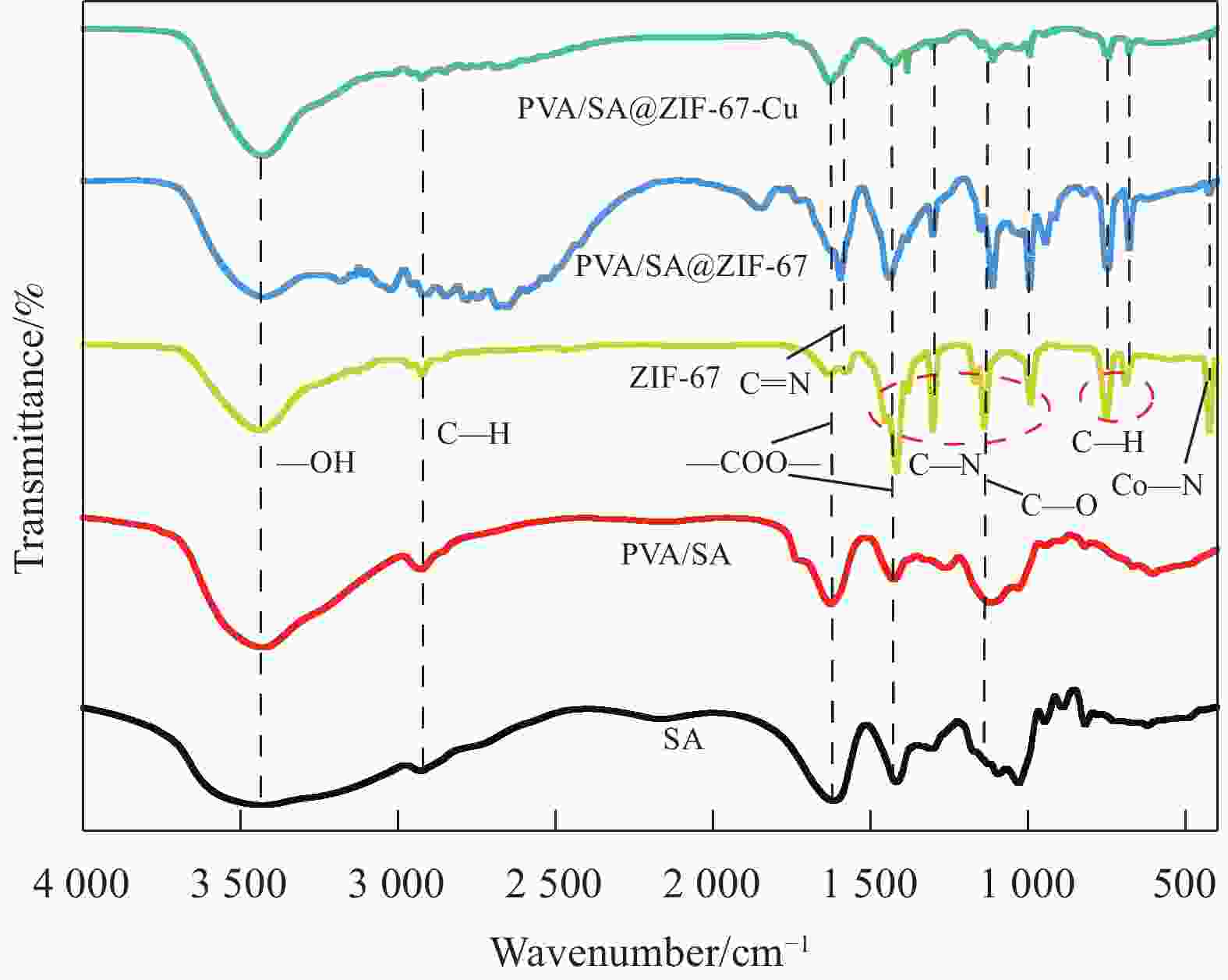
 下载:
下载:


